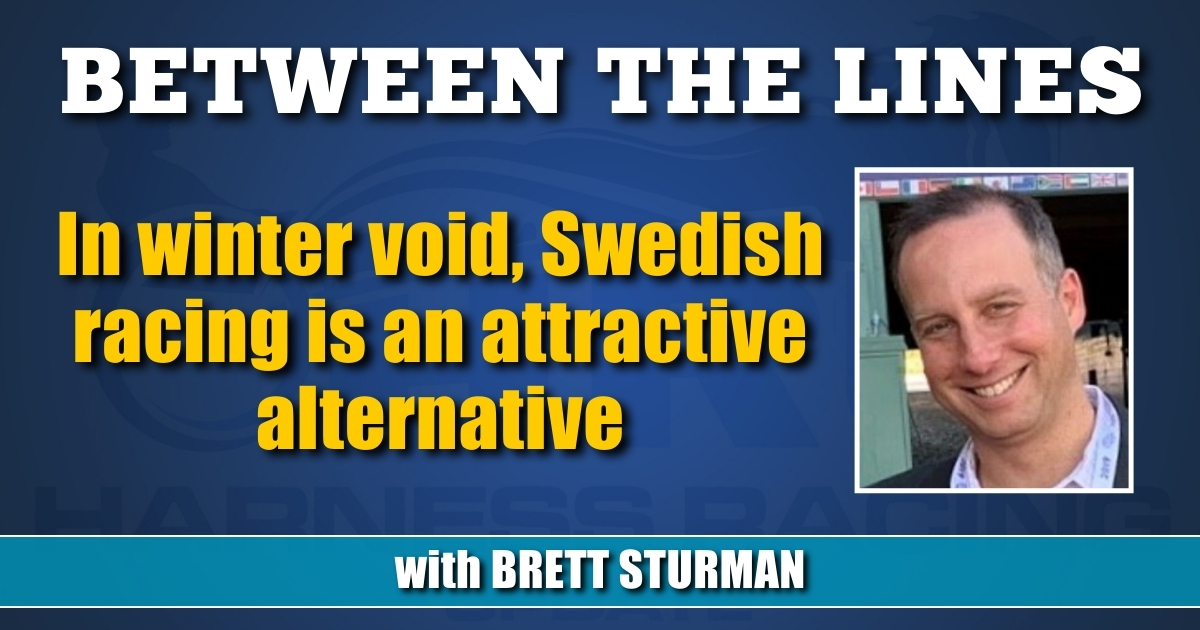In winter void, Swedish racing is an attractive alternative
by Brett Sturman
An already light January harness racing calendar has been further trimmed over these past couple of weeks with continual cancellations related to winter weather. Going back over the last full week, there hasn’t been a day without at least one track canceling. From Tuesday earlier this week as an example, with the cancellation of racing at Monticello, there wasn’t a single thoroughbred or harness racetrack conducting live racing until Miami Valley went post-ward later that afternoon at 4:00 p.m.
While harness racing here in North America has had a limited number of racing days over that time, racing in Europe, and Sweden in particular, has been evidently undeterred by the wintry conditions. And in this day and age of international simulcasting, harness racing from Sweden can be viewed and wagered on from the early morning hours to well into the afternoon, during times when early afternoon U.S. tracks have been forced to cancel.
For those less familiar, there is much that racing from Sweden offers and, in many ways, I’d argue is quite superior to that of racing here. All the things such as complete fields, a competitive style of racing and large pools can be seen race in and race out throughout that country with routine. Take the action-packed racing style here in the U.S. at Northfield Park. If you were to expand that same style to a larger size track with a couple more horses and make the races a longer distance, that’s how I’d describe racing in Sweden.
The most well-known track in that country is Solvalla Racetrack, home of Elitloppet. After that, the next best-known track may be Jägersro Racetrack. Jägersro had a card on Tuesday when most North American tracks canceled, and the very first race that day exemplified Swedish racing.
In that race, a field of 10 went to post at a distance of 2,140 meters, which equates to a little more than a mile and a quarter. With the track configuration, horses were let go at where the finish line is, with the trip consisting of two full circuits. Right from the start, there was a three-wide skirmish for the lead and already with the first quarter of the race complete, there were five horses on the inside and five horses in a fully formed and moving outer flow.
One of the key differences in styles of racing internationally compared to here is how horses race first-over. Horses in Sweden and elsewhere have an amazing ability to race parked uncovered for almost an entire duration of the race and still have a chance. In that first race from Jägersro, the horse that was first-over, or in the death-seat, as it’s called there, was parked the mile while racing outside the leader on the inside. Going around the final turn with 500 meters to go, the parked horse was able to further assert himself and put away his foe to the inside, and only lost in the stretch to the race favorite. In another contrast to domestic racing where racing is dominated on the front-end, it was the favorite — who was parked last and 10th on the outside — who ended up making up massive amounts of late ground to surge for the win.
Part of the competitive nature of the race comes from an actual enforcement of the rules, something that here in North America judges aren’t always keen to uphold. On the topic of changing positions and giving advance, Swedishhorseracing.com states “A driver may not intentionally change position to help another horse improve its position or by any other means give an advantage to another horse and driver.”
All put together, it simply makes for an engaging product. In addition to how the races are run, the horsemen are top notch. Bjorn Goop, Ulf Ohlsson and Örjan Kihlström have made winning appearances in major races the U.S. through the years and are arguably just as good as any other drivers worldwide. Everything else related to the European product storylines are documented brilliantly here in Harness Racing Update by Thomas Hedlund, and it’s easy to quickly discover who the leading players at each track are.
Another interesting aspect of the racing is the program. Like most other forms of international racing, past performances don’t track a horse at every pole call, but it does provide all other information, including a feature that captures odds movement. For any horse, you can go back to all the recent races and see not only that horse’s final odds, but what specifically was the odds trend at five different intervals that go through post-time and official time. This way, one could easily track and identify which horses in a given race took early money, took late money, took sudden action or drifted noticeably in price throughout the wagering process.
Whether it be Jägersro, Solvalla, or any other trotting track that ran this week such as Axevalla, Aby and a slew of others, they all offer multi-leg wagers that offer the potential to win tens or hundreds of thousands of dollars, and in rare cases even millions of dollars. For those who may only watch racing from Sweden once or twice a year for Elitloppet and maybe a couple of other major races, there’s certainly plenty of reasons to pay attention throughout the year. Especially from here in North America when race days are harder to come by.

















